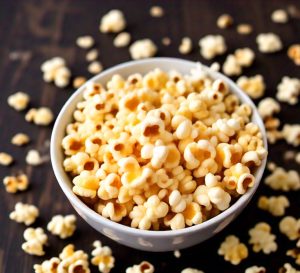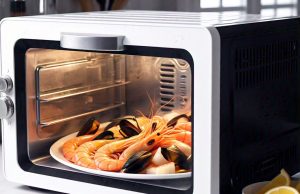Popcorn is a type of corn that expands from the kernel and puffs up when it’s heated.
The question here is whether you can make popcorn without using a microwave or not.
In this article, we will discuss how popcorn can be made even without a microwave. We will explore various alternatives to microwaving popcorn, such as using stovetop methods or an air popper. We’ll also delve into important facts about popcorn itself, including its nutritional value and how heat affects it. You’ll learn what happens to the flavor and nutrients of popcorn when it’s heated in different ways besides microwaving. Furthermore, safety tips on making popcorn without a microwave will also be provided along with frequently asked questions regarding this topic for your convenience and final words summarizing our findings.

Jump To:
Is it Possible to Make Popcorn without Using a Microwave?
Yes, you can indeed prepare popcorn without the use of a microwave. This could be achieved by utilizing alternate cooking methods such as stovetop or an air popper. The process involves heating up kernels in a pot on your stove or in an air popper device until they pop into fluffy popcorn. Regardless of the method used, careful monitoring is essential to prevent burning and ensure optimal popping.
Facts About Popcorn
Here, we will discuss the important things to note about popcorn.
- Nutrients: Popcorn is high in fiber and has a reasonable amount of protein. It also contains small amounts of vitamins and minerals like vitamin B3 (niacin), iron, magnesium, phosphorous, potassium, zinc, copper and manganese.
- Calories: A serving of air-popped popcorn contains approximately 30-35 calories per cup.
- Preparation method: Though commonly made in a microwave using popcorn bags or traditional stovetop methods with oil are available as well. Making popcorn without a microwave involves heat from an oven or stove that expands the water inside each kernel until it pops into its white airy self.
- Varieties:: There are various types such as white corn popcorn and yellow corn popcorn. White kernel popcorn tends to be smaller but more tender than yellow kernels when popped.
In conclusion, making delicious homemade popcorn doesn’t always require a microwave!
Now we will further discuss some other aspects related to microwaving popcorn.
What are the Alternatives to Microwaving Popcorn?
The primary alternatives to microwaving popcorn include using a stovetop, an air popper, or an electric popper. The stovetop method involves heating up oil in a large pot and adding the popcorn kernels which will begin to pop when sufficiently heated. An air popper works by circulating hot air around the kernels until they burst open whereas an electric popper combines heat with a stirring motion to ensure even popping.
Check out if you can microwave popcorn in a toaster oven.
Tips to Microwave Popcorn
Here are a few useful tips to microwave popcorn:
- Always use fresh popcorn for best results.
- Don’t leave the microwave unattended while popping corn; stop it once pops slow down considerably.
- Use caution when removing the bag from the microwave because the steam inside can be hot.
- Avoid overcooking as it can result in a burnt taste and a hard texture on your popped corn.
- If available, try using popcorn setting on your microwave for optimal results.
We’ve discussed some essential queries related to making popcorn without a microwave and how you can still enjoy your favorite snack.
Check out if you can use microwave popcorn in a popcorn machine.
Now we will move on to frequently asked questions regarding this subject matter in our next section.

Frequently Asked Questions (FAQs)
Here, we will now look at the most commonly asked questions related to making popcorn without a microwave.
Can you make popcorn without a microwave?
Yes, you can make popcorn without a microwave. The traditional stovetop method is an excellent alternative where kernels are heated in a pot with oil over medium heat until they pop. Other appliances like air poppers and electric popcorn makers can also be used for popping corn efficiently.
Is stove-top popcorn healthier than microwaved one?
In terms of health benefits, stove-top popcorn offers more control over ingredients compared to microwaved ones. Therefore, if lower salt or butter content is preferred, stovetop is definitely healthier as it allows adjustment based on individual preference.
What’s the temperature needed to popcorn on the stovetop?
The ideal temperature to popcorn on the stovetop ranges from 450°F-475°F (232°C-246°C). It provides enough heat for water inside kernels to rapidly expand and burst open into fluffy popcorn pieces.
How long does it take to make popcorn without a microwave?
Making popcorn without using a microwave generally takes about 10 minutes when using stovetop methods. This includes heating time and actual popping time of approximately 5 minutes once optimal temperature has been reached.
We hope these answers help alleviate your concerns regarding making popcorn without a microwave!
Final Word
In conclusion, not only is it possible but quite simple and efficient to make delicious homemade popcorn even without having access to a microwave! Whether you use an old-school stovetop method or opt for other popping devices, control over the ingredients and popcorn’s tastes ultimately lies in your hands. Enjoy popping!



